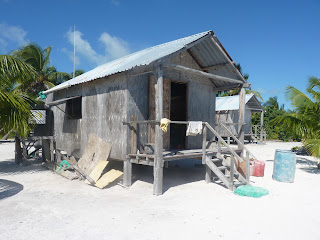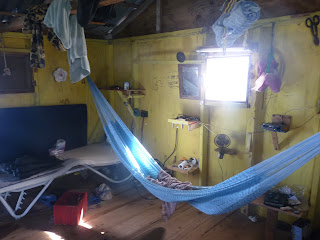Banco Chinchorro
January 28, 2012
January 28, 2012
The reef is around 25 miles long, and is comprised of three islands, Cayo Norte, Cayo Central and Cayo Lobos. The atoll is a continuous reef with six entries to the more shallow inside. It’s about 19 miles out from Mahahual where we left.
Last year we tried to go, but the weather didn’t cooperate. In late 2011, wrote to Dreamtime Dive Resort to enquire about a possible trip, cost, etc. and agreed to meet with them the first day of our stay in Mexico which we did. We waited 6 days and Saturday was predicted to finally be a calm enough day to go. We were only 4 and a minimum to go was 6. The two scuba guys cancelled, but they found 2 French couples.
Then our email went down, the telephones wouldn’t work, Marcia, at Mayan Beach Gardens allowed me to use her computer for email and plans were finalized for the morning.
As we had an unusually calm day, our trip out from Mahahual took about 55 minutes instead of two hours. Well, that was supposed to be the time, but it was a little longer because dolphins were sighted. We turned around a bit, and suddenly they were with us for a long time…right along side, many in front, and the wonderful fast swimming and up, up out of the water at times, leaping.
There are anywhere between 30 and 200 wrecks in total at Chinchorro. The list of ships that have ended their days on the reef is long and includes the Cassel, Far Star, Tropic, Huba, San Andres, SS Caldera, SS Escasell, SS Ginger Screw, SS Glen View and SS Penelopez just to name a few, and others so torn up, only their canons and the river rocks they used for ballast are left.
The first dive was with all kinds of colored tropical fish. I also marveled at the yellow balls, the size of basketballs or larger, that appeared to be some kind of brain coral.
 To see healthy, colorful coral was also a delight. Chinchorro harbors 70 species of soft and hard, or rock coral. (Diploria labyrinthiformis, also known as the grooved brain coral, is a brown or yellow hemispherical-shaped reef-building coral occurring in the Caribbean, the Bahamas, southern Florida, and Bermuda (Humann, 1993). It is most commonly found on offshore reefs at depths between 1 and 30 meters, growing to about 2 meters in diameter (Sterrer, 1986). Bermudian brain corals such as D. labyrinthiformis grow upward at a rate of about 3.5 millimeters per year.)
To see healthy, colorful coral was also a delight. Chinchorro harbors 70 species of soft and hard, or rock coral. (Diploria labyrinthiformis, also known as the grooved brain coral, is a brown or yellow hemispherical-shaped reef-building coral occurring in the Caribbean, the Bahamas, southern Florida, and Bermuda (Humann, 1993). It is most commonly found on offshore reefs at depths between 1 and 30 meters, growing to about 2 meters in diameter (Sterrer, 1986). Bermudian brain corals such as D. labyrinthiformis grow upward at a rate of about 3.5 millimeters per year.)Afterward we were a bit cold so ventured onward way out to the wreak of the Ginger Screw. Very spread out and only a few feet below me, I could imagine the sinking of this shrimp boat in 1956.…pipes, props, anchor, and bow.
Then we were off to the Central Cay.
 built out of wood and some painted on one end, mostly occupied with friendly fisherman. There is also a two story concrete buildings
built out of wood and some painted on one end, mostly occupied with friendly fisherman. There is also a two story concrete buildings that are said to house the scientists that come to study. It is the central hub of the Chinchorro National Park. However, We saw very little occupation in that area.
that are said to house the scientists that come to study. It is the central hub of the Chinchorro National Park. However, We saw very little occupation in that area. The inner lagoon has crocodiles that come to see if you’re bringing food.


 including the "toilet" over the water. He was smiling and cleaning fish for Chencho to take back to Mahahual. We saw many frigates, seagulls and pelicans there.
including the "toilet" over the water. He was smiling and cleaning fish for Chencho to take back to Mahahual. We saw many frigates, seagulls and pelicans there.After lunch we went northwest and snorkeled in an area with star fish. Also I saw three large turtles. One was “hiding” and we could watch him a long time. Each time we “dove,” Chencho and Pedro were in the water with us with bright flotation devices so we could see them. As there were swells and so much to see it was very e asy to spread out too much and they provided us with extra safety.
Coming back with the wind, we quickly returned about 5:30 PM. The cost was $125 American dollars or 1500 Pesos per person. Only 20% of those who try to go to Banco Chinchorro are successful, so we feel very privileged to have gone. There are few boats licensed to go, no one is allowed to go without being in a licensed boat by the Mexican Federal Government, and more important than all are the heavy seas so constant in the winter when most tourists wish to go.

January 25, 2012
Punto Herrera Fishing Village
We left Casa Amarilla at about 7:30 AM to begin our drive to Punto Herrero. We entered the dirt road in front of our rental house, finally turned off of it onto the Jungle asphalt road and drove north until turning right onto the road to Puticub. We took a left and soon were again on a dirt road with fairly deep potholes…lots of rock. Then the road turned to more sand than rock and the driving was easier. We passed Punta Mosquitero and on past a few native dwellings, many abandoned, view points, and finally arrived at about 9:30 AM. We stopped and talked to several fisherman about the possibility of taking us out in their fishing boat to the large Bahia Espiritu Santo. ( Holy Spirit Bay) in the Sian Ka’an Bioreserve.Biosphere Reserve
We finally ended up with Victor Ocun and Serio Moreno. Victor is in a 5 part program preparing him to be an official guide in the Bioreserve and is also President of the newly formed Tourism group in the village. He speaks English, but Serio does not.
We climbed into their boat and sped out toward a finger lagoon bordering the Bahia for about an hour seeing many kinds of birds and then back out and into the actual Bahia Espiritu Santo. It seemed huge to us.
We approached one island and Victor explained that before the hurricane Dean in 2007, it was alive with birds, especially the Roseate Spoonbill. We sped on and found the new site of the birds….they were cautious about us approaching, so Serio turned off the engine and we floated quietly toward the island. He turned on the engine as we swung around the island and approached the island from the west where they were perched. Many flew away, then came back. We entered a small cove and sat. The birds came back and then we noticed white Heron eggs in nests in the trees. That time was magic..bird calls, chattering and scores of Roseate Spoonbills alighting and flying, then returning again.
Next we went snorkeling in a small flowing riverlet. I saw whelps (like Conchs) walking along with their big black muscles extended. We also saw tubes with white rings suggesting a Pacific NW seaworm, but they are Whelp eggs that change into sharp pointed white eggs that adhere to rocks, etc. The water was low so we were right into the sand seeing things. Lunch, then back to the fishing village. Here is a photo of one fisherman's kitchen. They lead a simple life there.

On the way back we stopped at the Mosquitero Restaurant and were given a choice of a tray of fresh, whole, uncooked fish. We chose Pargo this time and the fish was cooked outback on a oil barrel. It was delicious and we were surprised to be also given rice, beans, cucumbers, salad, and home made tortillas.
From Mayan Beach Gardens it takes about 2 hours of slow driving on dirt roads for the most part and lots of potholes. We didn’t need a 4 wheel drive because it is the dry season. I imagine it would be very gummy and difficult in the wet season. We paid 1300 pesos plus tip for the 4 of us for about 4 hours. We brought our own lunches with us.
We highly recommend the trip.
We moved 5 km south of Casa Maria to Casa Amarilla owned by Jerry and Lynn Zimpleman (caretakers Hugh and Deb Blackburn). We LOVE the house. The best is the screened porch. We LIVE there....the house is about 30 feet from the white sandy shore.
The tiles are slightly ridged so you don't slip; they are the color of sand and earth so they don't show sand or dirt; the lounge chairs have charteuse green comfortable cushions and there is a table for at least 8...plus a gas barbecue. The salt does adhere to the screen, but it mostly looks like glass. Long, long sliding glass doors separate it from the living room and those are locked at night.
 Two bedrooms, an alcove with a futon for the children, a fully equipped kitchen with a central island that looks out through the sliding glass doors directly to the Caribbean.
Two bedrooms, an alcove with a futon for the children, a fully equipped kitchen with a central island that looks out through the sliding glass doors directly to the Caribbean.The plan of the house is totally to my liking.









VERY NICE!
ReplyDelete